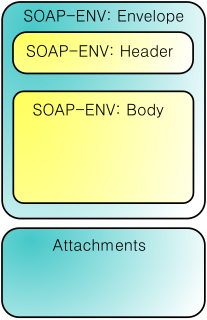In computer science, in the context of data storage, serialization is the process of translating data structures or object state into a format that can be stored or transmitted and reconstructed later. When the resulting series of bits is reread according to the serialization format, it can be used to create a semantically identical clone of the original object. For many complex objects, such as those that make extensive use of references, this process is not straightforward. Serialization of object-oriented objects does not include any of their associated methods with which they were previously linked.

SOAP is a messaging protocol specification for exchanging structured information in the implementation of web services in computer networks. Its purpose is to provide extensibility, neutrality and independence. It uses XML Information Set for its message format, and relies on application layer protocols, most often Hypertext Transfer Protocol (HTTP) or Simple Mail Transfer Protocol (SMTP), for message negotiation and transmission.
Abstract Syntax Notation One (ASN.1) is a standard interface description language for defining data structures that can be serialized and deserialized in a cross-platform way. It is broadly used in telecommunications and computer networking, and especially in cryptography.
Web Services Security is an extension to SOAP to apply security to Web services. It is a member of the Web service specifications and was published by OASIS.
XML Signature defines an XML syntax for digital signatures and is defined in the W3C recommendation XML Signature Syntax and Processing. Functionally, it has much in common with PKCS#7 but is more extensible and geared towards signing XML documents. It is used by various Web technologies such as SOAP, SAML, and others.
Direct Internet Message Encapsulation (DIME) was a Microsoft-proposed internet standard in the early 2000s for the streaming of binary and other encapsulated data over the Internet.

The Blocks Extensible Exchange Protocol (BEEP) is a framework for creating network application protocols. BEEP includes building blocks like framing, pipelining, multiplexing, reporting and authentication for connection and message-oriented peer-to-peer (P2P) protocols with support of asynchronous full-duplex communication.
Various binary formats have been proposed as compact representations for XML. Using a binary XML format generally reduces the verbosity of XML documents thereby also reducing the cost of parsing, but hinders the use of ordinary text editors and third-party tools to view and edit the document. There are several competing formats, but none has yet emerged as a de facto standard, although the World Wide Web Consortium adopted EXI as a Recommendation on 10 March 2011.
Fast Infoset is an international standard that specifies a binary encoding format for the XML Information Set as an alternative to the XML document format. It aims to provide more efficient serialization than the text-based XML format.
XML Information Set is a W3C specification describing an abstract data model of an XML document in terms of a set of information items. The definitions in the XML Information Set specification are meant to be used in other specifications that need to refer to the information in a well-formed XML document.
In computer networking, a wire protocol refers to a way of getting data from point to point: A wire protocol is needed if more than one application has to interoperate. It generally refers to protocols higher than the physical layer. In contrast to transport protocols at the transport level, the term "wire protocol" is used to describe a common way to represent information at the application level. It refers only to a common application layer protocol and not to a common object semantic of the applications. Such a representation at application level needs a common infoset and a data binding.

SOAP with Attachments (SwA) or MIME for Web Services is the use of web services to send and receive files with a combination of SOAP and MIME, primarily over HTTP.
OPC Unified Architecture is a machine to machine communication protocol for industrial automation developed by the OPC Foundation. Distinguishing characteristics are:
Thrift is an interface definition language and binary communication protocol used for defining and creating services for numerous languages. It forms a remote procedure call (RPC) framework and was developed at Facebook for "scalable cross-language services development". It combines a software stack with a code generation engine to build cross-platform services which can connect applications written in a variety of languages and frameworks, including ActionScript, C, C++, C#, Cappuccino, Cocoa, Delphi, Erlang, Go, Haskell, Java, Node.js, Objective-C, OCaml, Perl, PHP, Python, Ruby, Rust, Smalltalk and Swift. Although developed at Facebook, it is now an open source project in the Apache Software Foundation. The implementation was described in an April 2007 technical paper released by Facebook, now hosted on Apache.
Web Services Enhancements (WSE) is an obsolete add-on to the Microsoft .NET Framework, which includes a set of classes that implement additional WS-* web service specifications chiefly in areas such as security, reliable messaging, and sending attachments. Web services are business logic components which provide functionality via the Internet using standard protocols such as HTTP. Web services communicate via either SOAP or REST messages. WSE provides extensions to the SOAP protocol and allows the definition of custom security, reliable messaging, policy, etc. Developers can add these capabilities at design time using code or at deployment time through the use of a policy file.
gSOAP is a C and C++ software development toolkit for SOAP/XML web services and generic XML data bindings. The gSOAP tools generate efficient source code for XML serialization of any type of C/C++ data with zero-copy overhead.
Metro is a high-performance, extensible, easy-to-use web service stack and is a part of the GlassFish Application Server. Metro incorporates JAXB 2.x RI and JAX-WS 2.x Web services standards, along with other XML-related Java standards. Metro also includes added nonstandard components to support both basic JAX-WS service definition and usage and a variety of WS-* extensions to SOAP message exchange.


